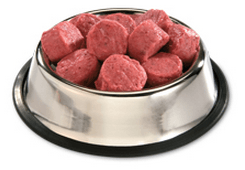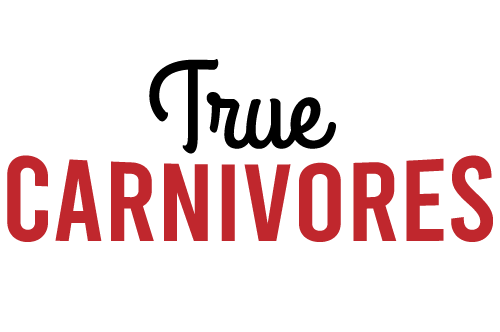A fresh food diet vs A processed food diet for your pets: You decide.
William Pollak, DVM
Survival is insured by commercial food; nothing more; not health, not the robustness for life.
WHAT ARE THE BENEFITS OF FEEDING RAW?
Some of our favorite ‘feel-good’ moments are seeing exuberantly excited & happy dogs walk into our store with their equally excited human to pick up their second, third, fourth and even tenth order of fresh food!
To tell you all the benefits of feeding fresh food to our pets would result in us writing an essay, so instead, we picked some of our favourites.
• Boosted immune system – stronger disease resistance
• No more ‘doggy’ odour – dogs smell fresh, clean
• Healthy skin & shiny coat
• Clean teeth, healthy gums, and fresh breath
• Improved digestion – no more ‘irritable bowels’/diarrhea
• Smaller stool & much less stinky!
• Fewer or no fleas & less scratching/itching
• All-around increased energy & vitality
• Old dogs get ‘younger’ – arthritis and inflammation lessens
• Dogs (and cats) look forward to their meals!
WHAT IS PROCESSED FOOD?

To put this lightly, it’s not food. “Discovered” in the early 1900’s as an answer to wartime meat shortages, companies such as Nestle and Purina began creating  commercial “kibble” and canned pet food. The ingredients in these foods included moldy grains, rancid restaurant grease (dogs like the smell!), diseased animal tissue, and “animal meal” which can include ground feathers, claws, blood, and fecal matter, just to name a few.
commercial “kibble” and canned pet food. The ingredients in these foods included moldy grains, rancid restaurant grease (dogs like the smell!), diseased animal tissue, and “animal meal” which can include ground feathers, claws, blood, and fecal matter, just to name a few.
Companies making kibble nowadays have amped up their marketing – still hiding what they are truly putting in their so-called “food”. They target specific markets by catering to activity levels, age levels, health issues…. you name it. Who is really making your so-called “pet food” and what are they putting in it?

GRAINS
Grains are not a part of a dog’s natural diet – in fact, dogs have difficulty in digesting grains. Kibble is usually very high in grain content. Why? Grains are inexpensive (compared to meat). However, a high grain diet can cause insulin swings and overwork the pancreas. Grain-free kibbles are often not much better, being filled with potatoes, peas and other starchy vegetables.
DIET TESTS DONE
Tested over the centuries by wild dogs that have continued to thrive in the wild by feasting on their prey (stomach, organs, intestines, muscle meat, bones, and stomach contents consisting of predigested root vegetables, grasses, fruits, and berries).
Not tested by any long term feeding trials, commercial “kibble” and canned pet foods were “discovered” in the 1950′s. Companies like Heinz, Nestle et al created a “niche” for their left-over “not fit for human consumption” foods. The results? We are seeing the rise in allergies, pancreatic and thyroid problems, dysplasia, and other degenerative diseases.
RAW VS COOKED BONES:
Raw bones are nature’s storehouse for minerals, in perfect balance. They act as a natural toothbrush – to clean teeth, exercise gums. No need to clean your dog’s teeth, or anesthetize, as the vet would have to do.
Chewing raw bones help to develop a puppy’s jaw and neck muscles.
Cooking destroys and/or alters many of the bone’s nutrients and changes essential fatty acids into “trans-fatty acids” – suspected carcinogens.
Cooked bones sit like concrete in a dog’s stomach, whereas raw bones break down. They can also splinter due to the breakdown of collagen.
 MEAT and VEGGIES: RAW VS COOKED
MEAT and VEGGIES: RAW VS COOKED
Raw food contains “enzymes” – necessary aids to digestion. It also contains amino acids – the building blocks of proteins.
Cooking kills the enzymes needed for proper digestion and stomach health. The body must work hard to replace them. Processing destroys fragile amino acids.
CANINE and FELINE PHYSIOLOGY
Wolves and dogs have identical gastrointestinal systems.
Their natural stomach juices are acidic, able to “kill” bacteria like salmonella, etc.
Dogs have “ripping, tearing and shearing” teeth. (No grinders, like humans, have)
Cats are true carnivores and cannot live in health without meat. (Francis J. Pottenger’s 10-year study on raw vs cooked foods for cats)
Cooked, carbohydrate-based pet foods are not natural to dogs and cats. They create an “alkaline” stomach environment – with lowered defenses against bacteria, etc.
French chemist, Paul Kouchakoff discovered that when cooked/processed food is tasted, white blood cells rush to the intestines. The phenomenon, called “digestive leucocytosis” disrupts the immune system: the body regards the cooked food as a pathogen and works hard to destroy it.
WHAT THE VETS SAY
There is move toward a return to a more natural diet for our companion animals, and there are a growing number of veterinarians in the Greater Vancouver area who now support and see the benefits of the raw food diet.
Vet schools receive their major funding – and “nutritional training” – from the multi-national pet food companies.
Fresh, raw foods are not a part of the traditional veterinary culture. Kibble is “convenient” (for the owner only.)
CONTROL OVER WHAT YOUR DOG/CAT EATS
Feeding raw, you have control over the quality, content, and quantity of your pet’s diet – it doesn’t come pre-mixed, or tinned.
“Variety” – important for both human and animal health – not the same bag of food day-in and day-out.
With commercial pet foods, you are never sure of the “quality” of the original ingredients. (Remember that shoe leather is “protein”!)
Many manufacturers use toxic additives that have been added to the food before they get it – and therefore don’t have to note it on their label!
ESSENTIAL FATTY ACIDS
Raw foods contain essential fatty acids necessary for a healthy coat and skin.
Heat and light can destroy EFA’s, yielding harmful trans-fatty acids. Pet food companies often use rancid, restaurant grease to spray on the kibble – dogs are “attracted” to the “smell”!
RAW VS COOKED and PROCESSED
A varied, species-appropriate raw food diet provides an abundance of all the nutrients dogs and cats need to live a healthy life.
Cats and dogs eat their prey raw – as nature intended.
Cooking/heating damages and alters food.
Damaged fats directly suppress the immune system.
Commercial pet food companies have yet to find ovens, dehydrators, or rendering plants in a wild cat or dog’s den!
ADDITIVES
A raw food diet does not need any chemicals, preservatives, or additives.
Some pet food companies use known cancer-causing preservatives like BHT, BHA, and Ethoxyquin in their food. Some add “food enhancers” that make food “taste better” – often “addicting” animals to one brand of food.
PROTEIN
Animal sources (easily digested and assimilated by dogs and cats)
High grain sources (not easily digested)
VARIETY
Variety in the diet helps to avert allergies, and ensure a well-rounded diet. With a raw food diet, this is possible.
On a kibble diet, there is no variety. Your pet eats the same thing, day after day. (How well would we fare if fed only “fast foods” for all of our life?)


